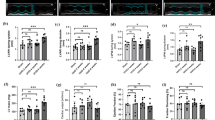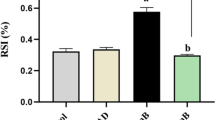Abstract
Survival time of kidney transplant patients is primarily threatened by chronic allograft dysfunction (CAD), whose typical feature is interstitial fibrosis and tubular atrophy (IF/TA). CAD could be caused by ischemia–reperfusion injury (IRI) during renal transplantation. MiR-378 is correlated with multiple kidney diseases and implicated in CAD. To clarify the underlying mechanism of miR-378 on renal allograft, we utilize renal unilateral IRI mice and H/R NRK52E cells. To evaluate the acute tubular damage, we determined the apoptotic rate by TUNEL assay and examined mice kidney sections of H&E staining 1 day after IRI. To assess the chronic renal interstitial inflammation and fibrosis, we detected the infiltration rates of CD45R+ leukocytes and Ly6b+ neutrophils by immunohistochemistry, examined mice kidney sections of picrosirius staining and measured the mRNA level of Col1a1 14 days after IRI. To investigate the H/R injury of NRK52E cells, MTT assay was performed to detect cell viability, TUNEL assay was performed to determine apoptotic rate and luciferase reporter assay was carried out to demonstrate the potential target of miR-378. Moreover, we determined the levels of miR-378 of renal allograft biopsies in healthy patients and patients diagnosed with IF/TA. We found agomir-378 treatment significantly reduced the apoptotic rate and tubular damage scores assessed by H&E staining 1 day after IRI. Agomir-378 treatment also decreased infiltration rates of both CD45R+ leukocytes and Ly6b+ neutrophils and fibrosis examined by picrosirius staining and by the mRNA level of Col1a1 14 days after IRI. Experiments in vitro revealed that miR-378 increased cell viability and decreased apoptotic rate of NRK52E cells subjected to H/R. Additionally, luciferase reporter assay confirmed that caspase 3 was targeted by miR-378 directly. Furthermore, we found the levels of miR-378 were significantly lower in renal allografts of patients with IF/TA than those of healthy controls. Taken together, we have found that miR-378 has potential protective effects on renal allografts to prevent IRI during kidney transplantation and following IF/TA of renal allografts.





Similar content being viewed by others
References
Scian MJ, Maluf DG, David KG et al (2011) MicroRNA profiles in allograft tissues and paired urines associate with chronic allograft dysfunction with IF/TA. Am J Transplant 11(10):2110–2122. https://doi.org/10.1111/j.1600-6143.2011.03666.x
Soltaninejad E, Nicknam MH, Nafar M et al (2015) Altered expression of micrornas following chronic allograft dysfunction with interstitial fibrosis and tubular atrophy. Iran J Allergy Asthma Immunol 14(6):10
Wilflingseder J, Jelencsics K, Bergmeister H et al (2017) miR-182-5p inhibition ameliorates ischemic acute kidney injury. Am J Pathol 187(1):70–79. https://doi.org/10.1016/j.ajpath.2016.09.011
Schauerte C, Hubner A, Rong S et al (2017) Antagonism of profibrotic microRNA-21 improves outcome of murine chronic renal allograft dysfunction. Kidney Int 92(3):646–656. https://doi.org/10.1016/j.kint.2017.02.012
Ledeganck KJ, Gielis EM, Abramowicz D, Stenvinkel P, Shiels PG, Van Craenenbroeck AH (2019) MicroRNAs in AKI and kidney transplantation. Clin J Am Soc Nephrol 14(3):454–468. https://doi.org/10.2215/CJN.08020718
Wolenski FS, Shah P, Sano T et al (2017) Identification of microRNA biomarker candidates in urine and plasma from rats with kidney or liver damage. J Appl Toxicol 37(3):278–286. https://doi.org/10.1002/jat.3358
Fedorko M, Stanik M, Iliev R et al (2015) Combination of MiR-378 and MiR-210 serum levels enables sensitive detection of renal cell carcinoma. Int J Mol Sci 16(10):23382–23389. https://doi.org/10.3390/ijms161023382
Shi L, Zhang L, Wang C, Sun S, Cao X, Zhang X (2017) Expression of serum microRNA-378 and its clinical significance in renal cell carcinoma. Genet Mol Biol 40(2):525–529. https://doi.org/10.1590/1678-4685-GMB-2016-0121
Lei X, Zhang B, Ren J, Luo F (2018) Astragaloside suppresses apoptosis of the podocytes in rats with diabetic nephropathy via miR-378/TRAF5 signaling pathway. Life Sci 206:77–83. https://doi.org/10.1016/j.lfs.2018.05.037
Wang B, Yao K, Wise AF et al (2017) miR-378 reduces mesangial hypertrophy and kidney tubular fibrosis via MAPK signalling. Clin Sci 131(5):411–423. https://doi.org/10.1042/CS20160571
Wilflingseder J, Regele H, Perco P et al (2013) miRNA profiling discriminates types of rejection and injury in human renal allografts. Transplantation 95(6):835–841. https://doi.org/10.1097/TP.0b013e318280b385
Ben-Dov IZ, Muthukumar T, Morozov P, Mueller FB, Tuschl T, Suthanthiran M (2012) MicroRNA sequence profiles of human kidney allografts with or without tubulointerstitial fibrosis. Transplantation 94(11):1086–1094. https://doi.org/10.1097/TP.0b013e3182751efd
Meldrum KK, Meldrum DR, Hile KL, Burnett AL, Harken AH (2001) A novel model of ischemia in renal tubular cells which closely parallels in vivo injury. J Surg Res 99(2):288–293. https://doi.org/10.1006/jsre.2001.6201
Amrouche L, Desbuissons G, Rabant M et al (2017) MicroRNA-146a in human and experimental ischemic AKI: CXCL8-dependent mechanism of action. J Am Soc Nephrol 28(2):479–493. https://doi.org/10.1681/ASN.2016010045
Kamejima S, Tatsumi N, Anraku A et al (2019) Gcm 1 is involved in cell proliferation and fibrosis during kidney regeneration after ischemia–reperfusion injury. Sci Rep 9(1):7883. https://doi.org/10.1038/s41598-019-44161-y
Colvin RB (2003) Chronic allograft nephropathy. N Engl J Med. 2003:3
Nankivell BJ (2003) The natural history of chronic allograft nephropathy. N Engl J Med 2003:8
Eichner LJ, Perry M-C, Dufour CR et al (2010) miR-378(star) mediates metabolic shift in breast cancer cells via the PGC-1 beta/ERR gamma transcriptional pathway. Cell Metab 12(4):352–361. https://doi.org/10.1016/j.cmet.2010.09.002
Krist B, Florczyk U, Pietraszek-Gremplewicz K, Jozkowicz A, Dulak J (2015) The role of miR-378a in metabolism, angiogenesis, and muscle biology. Int J Endocrinol. https://doi.org/10.1155/2015/281756
Urbich C, Kuehbacher A, Dimmeler S (2008) Role of microRNAs in vascular diseases, inflammation, and angiogenesis. Cardiovasc Res 79(4):581–588. https://doi.org/10.1093/cvr/cvn156
Lee DY, Deng Z, Wang C-H, Yang BB (2007) MicroRNA-378 promotes cell survival, tumor growth, and angiogenesis by targeting SuFu and Fus-1 expression. Proc Natl Acad Sci USA 104(51):20350–20355. https://doi.org/10.1073/pnas.0706901104
Li Y, Wen S, Yao X et al (2017) MicroRNA-378 protects against intestinal ischemia/reperfusion injury via a mechanism involving the inhibition of intestinal mucosal cell apoptosis. Cell Death Dis 8(10):e3127. https://doi.org/10.1038/cddis.2017.508
Fang J, Song X-W, Tian J et al (2012) Overexpression of microRNA-378 attenuates ischemia-induced apoptosis by inhibiting caspase-3 expression in cardiac myocytes. Apoptosis 17(4):410–423. https://doi.org/10.1007/s10495-011-0683-0
Gao X, Wu G, Gu X, Fu L, Mei C (2013) Kruppel-like factor 15 modulates renal interstitial fibrosis by ERK/MAPK and JNK/MAPK pathways regulation. Kidney Blood Pressure Res 37(6):631–640. https://doi.org/10.1159/000355743
Lan HY, Chung ACK (2012) TGF-beta/Smad signaling in kidney disease. Semin Nephrol. 32(3):236–243. https://doi.org/10.1016/j.semnephrol.2012.04.002
Li JY, Yong TY, Michael MZ, Gleadle JM (2010) Review: the role of microRNAs in kidney disease. Nephrology 15(6):599–608. https://doi.org/10.1111/j.1440-1797.2010.01363.x
Wei Q, Mi Q-S, Dong Z (2013) The regulation and function of micrornas in kidney diseases. IUBMB Life 65(7):602. https://doi.org/10.1002/iub.1174
Author information
Authors and Affiliations
Contributions
LX designed the study, conducted most of the experiments and wrote the manuscript; SD and TY conducted the experiments and analyzed the data.
Corresponding author
Ethics declarations
Conflict of interest
The authors declare there is no conflict of interest in this study.
Consent for publication
All authors agreed the submission and the policy of the journal and copyright.
Availability of data and material
All data in this study can be obtained by proper request from the authors.
Additional information
Publisher's Note
Springer Nature remains neutral with regard to jurisdictional claims in published maps and institutional affiliations.
Rights and permissions
About this article
Cite this article
Xiong, L., Ding, S. & Yang, T. The protective function of miR-378 in the ischemia–reperfusion injury during renal transplantation and subsequent interstitial fibrosis of the renal allograft. Int Urol Nephrol 52, 1791–1800 (2020). https://doi.org/10.1007/s11255-020-02540-9
Received:
Accepted:
Published:
Issue Date:
DOI: https://doi.org/10.1007/s11255-020-02540-9




